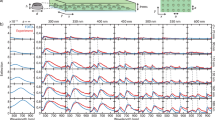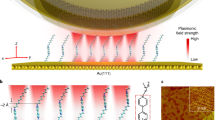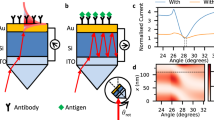Abstract
Perhaps the most successful application of plasmonics to date has been in sensing, where the interaction of a nanoscale localized field with analytes leads to high-sensitivity detection in real time and in a label-free fashion1,2,3,4,5,6,7,8,9. However, all previous designs have been based on passively excited surface plasmons, in which sensitivity is intrinsically limited by the low quality factors induced by metal losses. It has recently been proposed theoretically that surface plasmon sensors with active excitation (gain-enhanced) can achieve much higher sensitivities due to the amplification of the surface plasmons10,11,12. Here, we experimentally demonstrate an active plasmon sensor that is free of metal losses and operating deep below the diffraction limit for visible light. Loss compensation leads to an intense and sharp lasing emission that is ultrasensitive to adsorbed molecules. We validated the efficacy of our sensor to detect explosives in air under normal conditions and have achieved a sub-part-per-billion detection limit, the lowest reported to date for plasmonic sensors7,13,14,15,16,17,18 with 2,4-dinitrotoluene and ammonium nitrate. The selectivity between 2,4-dinitrotoluene, ammonium nitrate and nitrobenzene is on a par with other state-of-the-art explosives detectors19,20. Our results show that monitoring the change of the lasing intensity is a superior method than monitoring the wavelength shift, as is widely used in passive surface plasmon sensors. We therefore envisage that nanoscopic sensors that make use of plasmonic lasing could become an important tool in security screening and biomolecular diagnostics.
This is a preview of subscription content, access via your institution
Access options
Subscribe to this journal
Receive 12 print issues and online access
$259.00 per year
only $21.58 per issue
Buy this article
- Purchase on Springer Link
- Instant access to full article PDF
Prices may be subject to local taxes which are calculated during checkout





Similar content being viewed by others
References
Peng, G. et al. Diagnosing lung cancer in exhaled breath using gold nanoparticles. Nature Nanotech. 4, 669–673 (2009).
Liu, N., Tang, M. L., Hentschel, M., Giessen, H. & Alivisatos, A. P. Nanoantenna-enhanced gas sensing in a single tailored nanofocus. Nature Mater. 10, 631–636 (2011).
Anker, J. N. et al. Biosensing with plasmonic nanosensors. Nature Mater. 7, 442–453 (2008).
Kabashin, A. V. et al. Plasmonic nanorod metamaterials for biosensing. Nature Mater. 8, 867–871 (2009).
Cubukcu, E., Zhang, S., Park, Y-S., Bartal, G. & Zhang, X. Split ring resonator sensors for infrared detection of single molecular monolayers. Appl. Phys. Lett. 95, 043113 (2009).
Li, J. F. et al. Shell-isolated nanoparticle-enhanced Raman spectroscopy. Nature 464, 392–395 (2010).
Mayer, K. M. & Hafner, J. H. Localized surface plasmon resonance sensors. Chem. Rev. 111, 3828–3857 (2011).
Yanika, A. A. et al. Seeing protein monolayers with the naked eye through plasmonic Fano resonances. Proc. Natl Acad. Sci. USA 108, 11784–11789 (2011).
Brolo, A. G. Plasmonics for future biosensors. Nature Photon. 6, 709–713 (2012).
Lawandy, N. M. Localized surface plasmon singularities in amplifying media. Appl. Phys. Lett. 85, 5040–5042 (2004).
Gordon, J. A. & Ziolkowski, R. W. Investigating functionalized active coated nanoparticles for use in nano-sensing applications. Opt. Express 15, 12562–12582 (2007).
Li, Z-Y. & Xia, Y. Metal nanoparticles with gain toward single-molecule detection by surface-enhanced Raman scattering. Nano Lett. 10, 243–249 (2010).
Piorek, B. D., Lee, S. J., Moskovits, M. & Meinhart, C. D. Free-surface microfluidics/surface-enhanced Raman spectroscopy for real-time trace vapor detection of explosives. Anal. Chem. 84, 9700–9705 (2012).
Sylvia, J. M., Janni, J. A., Klein, J. D. & Spencer, K. M. Surface-enhanced Raman detection of 2,4-dinitrotoluene impurity vapor as a marker to locate landmines. Anal. Chem. 72, 5834–5840 (2000).
Khaing Oo, M. K., Chang, C-F., Sun, Y. & Fan, X. Rapid, sensitive DNT vapor detection with UV-assisted photo-chemically synthesized gold nanoparticle SERS substrates. Analyst 136, 2811–2817 (2011).
Bowen, J. et al. Gas-phase detection of trinitrotoluene utilizing a solid-phase antibody immobilized on a gold film by means of surface plasmon resonance spectroscopy. Appl. Spectrosc. 57, 906–914 (2003).
Baker, G. A. & Moore, D. S. Progress in plasmonic engineering of surface-enhanced Raman-scattering substrates toward ultra-trace analysis. Anal. Bioanal. Chem. 382, 1751–1770 (2005).
Tamane, S., Topal, C. & Kalkan, A. J. Vapor phase SERS sensor for explosives detection. Proceedings of the 11th IEEE International Conference on Nanotechnology 301–306 (2011).
Rose, A., Zhu, Z., Madigan, C. F., Swager, T. M. & Bulovic, V. Sensitivity gains in chemosensing by lasing action in organic polymers. Nature 434, 876–879 (2005).
Rochat, S. & Swager, T. M. Conjugated amplifying polymers for optical sensing applications. ACS Appl. Mater. Interfaces 5, 4488–4502 (2013).
He, L., Ozdemir, S. K., Zhu, J., Kim, W. & Yang, L. Detecting single viruses and nanoparticles using whispering gallery microlasers. Nature Nanotech. 6, 428–432 (2011).
Vahala, K. J. Optical microcavities. Nature 424, 839–846 (2003).
Vollmer, F. & Arnold, S. Whispering-gallery-mode biosensing: label-free detection down to single molecules. Nature Methods 5, 591–596 (2008).
Bergman, D. J. & Stockman, M. I. Surface plasmon amplification by stimulated emission of radiation: quantum generation of coherent surface plasmons in nanosystems. Phys. Rev. Lett. 90, 027402 (2003).
Hill, M. T. et al. Lasing in metal–insulator–metal sub-wavelength plasmonic waveguides. Opt. Express 17, 11107–11112 (2009).
Noginov, M. A. et al. Demonstration of a spaser-based nanolaser. Nature 460, 1110–1113 (2009).
Oulton, R. F. et al. Plasmon lasers at deep subwavelength scale. Nature 461, 629–632 (2009).
Ma, R-M., Oulton, R. F., Sorger, V. J., Bartal, G. & Zhang, X. Room temperature sub-diffraction-limited plasmon laser by total internal reflection. Nature Mater. 10, 110–113 (2011).
Khajavikhan, M. et al. Thresholdless nanoscale coaxial lasers. Nature 482, 204–207 (2012).
Lu, Y-J. et al. Plasmonic nanolaser using epitaxially grown silver film. Science 337, 450–453 (2012).
Ma, R-M., Yin, X. B., Oulton, R. F., Sorger, V. J. & Zhang, X. Multiplexed and electrically modulated plasmon laser circuit. Nano Lett. 12, 5396–5402 (2012).
Seker, F., Meeker, K., Kuech, T. F. & Ellis, A. B. Surface chemistry of prototypical bulk II–VI and III–V semiconductors and implications for chemical sensing. Chem. Rev. 100, 2505–2536 (2000).
Skoog, D. A., Holler, F. J. & Crouch, S. R. Principles of Instrumental Analysis 6th edn (Thomson Learning, 2006).
Acknowledgements
The authors acknowledge financial support from the US Air Force Office of Scientific Research (AFOSR, grant no. FA9550-12-1-0197).
Author information
Authors and Affiliations
Contributions
R-M.M. conducted theoretical simulations. R-M.M. and S.O. performed device fabrication and optical measurements. R-M.M. and S.O. wrote the manuscript. All authors discussed the results and contributed to the manuscript revision. X.Z. guided the research.
Corresponding author
Ethics declarations
Competing interests
The authors declare no competing financial interests.
Rights and permissions
About this article
Cite this article
Ma, RM., Ota, S., Li, Y. et al. Explosives detection in a lasing plasmon nanocavity. Nature Nanotech 9, 600–604 (2014). https://doi.org/10.1038/nnano.2014.135
Received:
Accepted:
Published:
Issue Date:
DOI: https://doi.org/10.1038/nnano.2014.135
This article is cited by
-
High-Q lasing via all-dielectric Bloch-surface-wave platform
Nature Communications (2023)
-
Plasmonic lasing in highly lossy nanocylinder arrays under optical pumping
Applied Physics B (2023)
-
Plasmonic nano-laser at 675 nm for biomedical applications
Journal of Optics (2023)
-
Creating hot spots within air for better sensitivity through design of oblique-wire-bundle metamaterial perfect absorbers
Scientific Reports (2022)
-
Spontaneous emission in micro- or nanophotonic structures
PhotoniX (2021)



